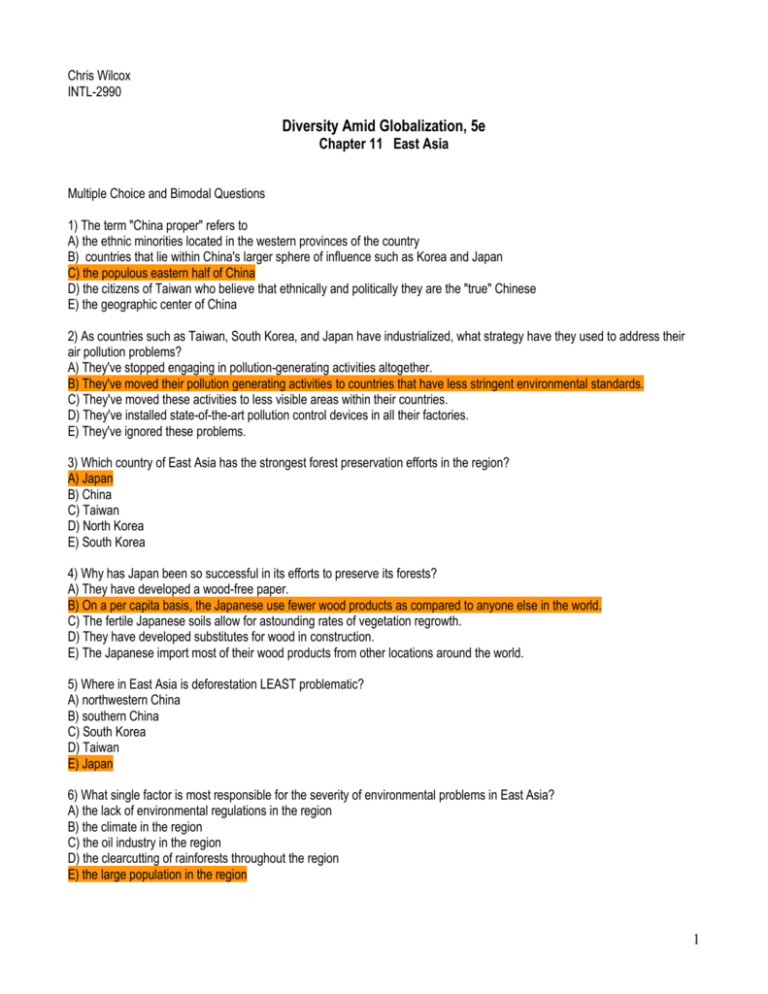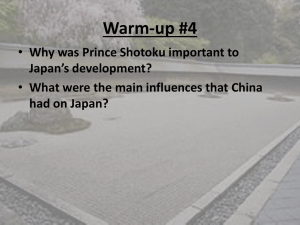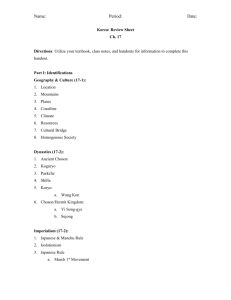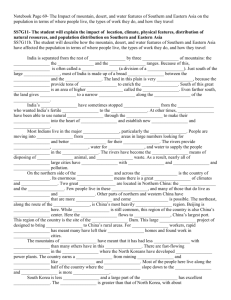Diversity Amid Globalization, 5e (Rowntree)
advertisement

Chris Wilcox INTL-2990 Diversity Amid Globalization, 5e Chapter 11 East Asia Multiple Choice and Bimodal Questions 1) The term "China proper" refers to A) the ethnic minorities located in the western provinces of the country B) countries that lie within China's larger sphere of influence such as Korea and Japan C) the populous eastern half of China D) the citizens of Taiwan who believe that ethnically and politically they are the "true" Chinese E) the geographic center of China 2) As countries such as Taiwan, South Korea, and Japan have industrialized, what strategy have they used to address their air pollution problems? A) They've stopped engaging in pollution-generating activities altogether. B) They've moved their pollution generating activities to countries that have less stringent environmental standards. C) They've moved these activities to less visible areas within their countries. D) They've installed state-of-the-art pollution control devices in all their factories. E) They've ignored these problems. 3) Which country of East Asia has the strongest forest preservation efforts in the region? A) Japan B) China C) Taiwan D) North Korea E) South Korea 4) Why has Japan been so successful in its efforts to preserve its forests? A) They have developed a wood-free paper. B) On a per capita basis, the Japanese use fewer wood products as compared to anyone else in the world. C) The fertile Japanese soils allow for astounding rates of vegetation regrowth. D) They have developed substitutes for wood in construction. E) The Japanese import most of their wood products from other locations around the world. 5) Where in East Asia is deforestation LEAST problematic? A) northwestern China B) southern China C) South Korea D) Taiwan E) Japan 6) What single factor is most responsible for the severity of environmental problems in East Asia? A) the lack of environmental regulations in the region B) the climate in the region C) the oil industry in the region D) the clearcutting of rainforests throughout the region E) the large population in the region 1 7) What country in East Asia has resorted to "pollution exporting" as a way to improve its environment? A) Japan B) China C) North Korea D) Singapore E) All of the choices are correct. 8) What is an anthropogenic landscape? A) a pristine, natural landscape, in its original state B) a landscape that anthropologists have studied extensively C) a landscape that has been heavily transformed by human activities D) a steppe-like landscape E) a landscape the bears an uncanny resemblance to the human physical form 9) Which of the following phrases best describes the agriculture in East Asia? A) highly productive B) highly productive, and produces enough for export C) unproductive D) highly productive, but does not produce enough to feed all the people in the region E) highly unproductive 10) Where is almost all of the rice that the Japanese consume grown? A) This is a trick question: it's grown in Japan. B) China C) Korea D) Southeast Asia E) New Zealand 11) Japan has a policy of self-sufficiency in which product? A) electronics B) rice C) steel D) seafood E) sushi 12) What is the major crop grown in Japan? A) vegetables B) fruits C) rice D) dairy E) opium poppies 13) East Asia is located in roughly the same latitudinal zone as which of the following world regions? A) Latin America B) North America C) The Caribbean D) Australia and Oceania E) Africa 2 14) In terms of its latitudinal extent, how does Japan compare to the state of California? A) Japan and California have just about the same latitudinal extent. B) Japan is wider and shorter than California. C) Japan is more elongated, extending farther north and south. D) Japan is narrower and longer than California. E) Japan is both wider and longer than California. 15) Which environmental hazard is the most serious in Japan (think March 2011)? A) deforestation B) hurricanes C) earthquakes D) tornadoes E) desertification 16) How many major islands make up Japan? A) 2 B) 3 C) 4 D) 5 E) 12 17) In which country of East Asia are earthquakes most frequent? A) western China B) northern China C) North Korea D) Japan E) central China 18) What climate type is found in most of Japan? A) tropical B) subarctic C) subtropical D) continental E) temperate 3 19) Which of the following cities of East Asia has the greatest seasonal variation in rainfall? A) Tokyo, Japan B) Shanghai, China C) Taipei, Taiwan D) Seoul, South Korea E) Akita, Japan 20) As of 2010, what was the approximate population of Japan? A) 34 million B) 63 million C) 100 million D) 128 million E) 157 million 21) What country in East Asia is facing a population decline? A) Taiwan B) China C) North Korea D) South Korea E) Japan 22) The populations of Japan and South Korea A) are predominately rural. B) reside in the upland areas of the nations. C) are concentrated along the central coasts of both nations. D) are concentrated mainly in cities. E) are evenly distributed around the two countries. 4 23) Which city in East Asia was called "Edo" in the 1700s? A) Tokyo B) Beijing C) Seoul D) Kyoto E) Hong Kong 24) Which of the following words is a synonym for superconurbation? A) urban primacy B) primate city C) megalopolis D) megacity E) edge city 25) What writing system forms the basis for the writing throughout East Asia? A) ideographs B) Arabic alphabet C) Cyrillic alphabet D) hieroglyphics E) Roman alphabet 26) What is the name of the belief system that deals with designing buildings and placing of objects on the landscape in accordance with the spiritual powers that course through the local topography? A) feng shui B) Shinto C) Confucianism D) Buddhism E) Falun Dafa 27) Confucianism stresses all of the following ideals, EXCEPT A) the importance of the family. B) deference to authority. C) the importance of ethics. D) respect for tradition. E) the need for the aristocracy to serve in the bureaucracy. 28) Who are the Ainu? A) an ethnic minority in Japan B) the political elite in China C) the wealthiest people in South Korea D) the secret police of North Korea E) the religious leaders of Taiwan 29) What is Kanji? A) the writing form used in Korea B) the Japanese term for the Chinese ideographs they borrowed to begin their writing system C) the quasi-alphabet used by the Japanese to express concepts that could not be expressed through Chinese characters D) a Roman alphabet version of the Japanese language E) the Chinese names for ideographs 5 30) What style of Japanese writing would the typical resident of the United States find the most familiar? A) Hiragana B) Kanji C) Katakana D) Romanji E) ideographs 31) Which country of East Asia has the greatest linguistic diversity? A) Taiwan B) China C) Japan D) Korea E) Hong Kong 32) According to most linguists, what other language is related to Japanese? A) Turkish B) Korean C) Chinese D) Vietnamese E) Japanese is not related to any other language. 33) The Shinto religion is most closely associated with which country of East Asia? A) China B) North Korea C) Japan D) South Korea E) Taiwan 6 34) In which country of East Asia has Confucian philosophy had the LEAST influence? A) Japan B) China C) Taiwan D) North Korea E) South Korea 35) With which country of East Asia is Taoism associated? A) Japan B) North Korea C) South Korea D) Taiwan E) China 36) In which of the following parts of East Asia has Japan controlled territory? A) Korea B) Manchuria and Xinjiang, China C) Xinjiang, China D) Taiwan and Korea E) Manchuria (China), Taiwan, Korea 7 37) Japan is involved in a conflict over the Kuril Islands with which other country? A) China B) Vietnam C) South Korea D) Russia E) Taiwan 38) Which East Asian country rose after World War II to become the second-largest economic power in the world? A) Japan B) China C) North Korea D) South Korea E) Taiwan 39) Japan's economy A) is currently the largest in the world. B) slowed substantially in the 1990s. C) has seen sustained gains in its real estate values over the last two decades. D) did not begin to industrialize until after World War II. E) is not as large as China's. 40) Which of the following products does Japan import? A) meat B) feed for its domestic livestock C) soybeans D) lumber and pulp 8







